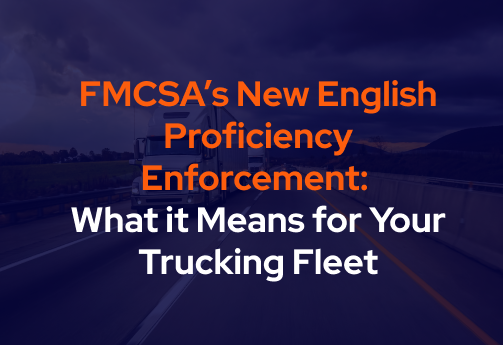FMCSA’s New English Proficiency Enforcement: What it means for your trucking fleet

The Federal Motor Carrier Safety Administration (FMCSA) has begun strictly enforcing an English language proficiency rule for commercial drivers as of late June 2025. During every roadside inspection, officers will now start by communicating in English, and drivers must respond in English without the help of interpreters or translation apps. If a driver cannot demonstrate the required English skills, they can be cited and even placed out of service on the spot. This new enforcement directive stems from a recent policy change and executive order emphasizing that all truck drivers operating in the U.S. be able to speak and understand English for safety.
Below, we break down what this means for HDVI-insured fleets, why it matters for safety and compliance, and how you can ensure your team is prepared.
What is the New English Proficiency Rule?
This new rule is a longstanding federal requirement that’s now being rigorously enforced. U.S. regulations (49 CFR §391.11(b)(2)) have long required commercial motor vehicle drivers to read and speak English well enough to:
- Converse with the general public and law enforcement officials in English
- Understand highway traffic signs and signals in English.
- Respond to official inquiries and directions from inspectors or officers.
- Fill out required reports and records in English.
For years, this English proficiency rule was on the books, but enforcement was inconsistent. Now that has changed. Following an Executive Order in April 2025, FMCSA issued new guidance on May 20, 2025, directing inspectors to “reawaken” enforcement of the English requirement. Starting June 25, 2025, the Commercial Vehicle Safety Alliance (CVSA) officially added English proficiency to its Out-of-Service Criteria.
In practice, this means any driver who cannot communicate sufficiently in English during an inspection may be immediately ordered out of service.
How will inspectors check English proficiency?
The FMCSA has outlined a two-step assessment for use during roadside stops:
- English Interview: The officer will conduct a brief conversation with the driver in English. The driver will be instructed to answer basic questions, such as their trip origin and destination, hours of service, license, or paperwork, in English. No interpreters, translation cards, or phone apps are allowed; the driver’s English ability must be on display. If the driver cannot adequately understand and respond in English, the test stops there – the driver fails and will be cited (and, under the new criteria, placed out of service) for not meeting the language requirement.
- Road Sign Test: If the driver passes the conversation portion, the inspector may then ask the driver to identify or explain common highway signs and signals (including electronic message boards) that they might encounter. This checks the driver’s ability to comprehend English-language traffic signage. Failing this step would also result in a violation and out-of-service order. (For carriers, FMCSA has even suggested using the Manual on Uniform Traffic Control Devices as a reference to quiz your drivers on sign meanings during training.)
Officers will not permit any outside help during these assessments. For instance, a driver cannot hand their phone to the inspector to translate, read off a prepared script, or use an “I Speak” card; those tools should not be used during the driver interview, as they may mask a driver’s inability to communicate in English. The goal is to ensure the individual driver truly has the functional English skills required. Drivers who are deaf or hard of hearing and hold FMCSA exemptions are handled under separate guidelines (they aren’t subject to an oral speaking test and have other accommodations). But for the vast majority of drivers, the rule is clear – “speak English or be parked.”
How trucking fleets can stay compliant and prepared
Given the high stakes, trucking company owners and safety managers should take proactive steps to comply with the English proficiency rule and avoid disruptions. Here are actionable measures your fleet can implement now:
- Assess English Skills: Conduct and document English proficiency checks during hiring and periodically for current drivers. This can be done by having them explain trip details or respond to mock inspection questions in English.
- Offer Targeted Training: Support drivers who need help through ESL tools or coaching. Reinforce common inspection terminology and signage comprehension.
- Update Policies: Incorporate English proficiency checks into your qualification requirements. Add language expectations to your handbook and orientation process.
- Prepare Drivers for Inspections: Explain that they must respond in English without help. Practice mock interviews to help drivers feel comfortable under pressure.
- Document Everything: Motor carriers are required to maintain a qualification file for each of their drivers. This checklist will help you ensure that each driver qualification file is complete. In addition, keep records of assessments, training, and any steps taken to correct deficiencies. This will help if you face a violation or legal challenge.
- Have a Backup Plan: If a driver is placed out of service, ensure you have a plan in place to recover the load promptly and assess the cause internally.
HDVI is here to help
HDVI encourages our insured fleets to treat this rule as a core safety standard, not just a compliance item. By ensuring your drivers meet the English proficiency standard, you’re not only avoiding fines or out-of-service orders, you’re also reducing the likelihood of miscommunications that could lead to costly accidents.
As a trucking company, ensuring your drivers meet this standard protects your business from violations and accidents. As your insurance partner, HDVI is committed to supporting you in this mission. By taking the steps outlined above, you can keep your fleet compliant, safe, and rolling without interruption.
If you have any questions or need assistance, reach out to HDVI Fleet Services – we’re here to help keep your drivers and operations safe.


